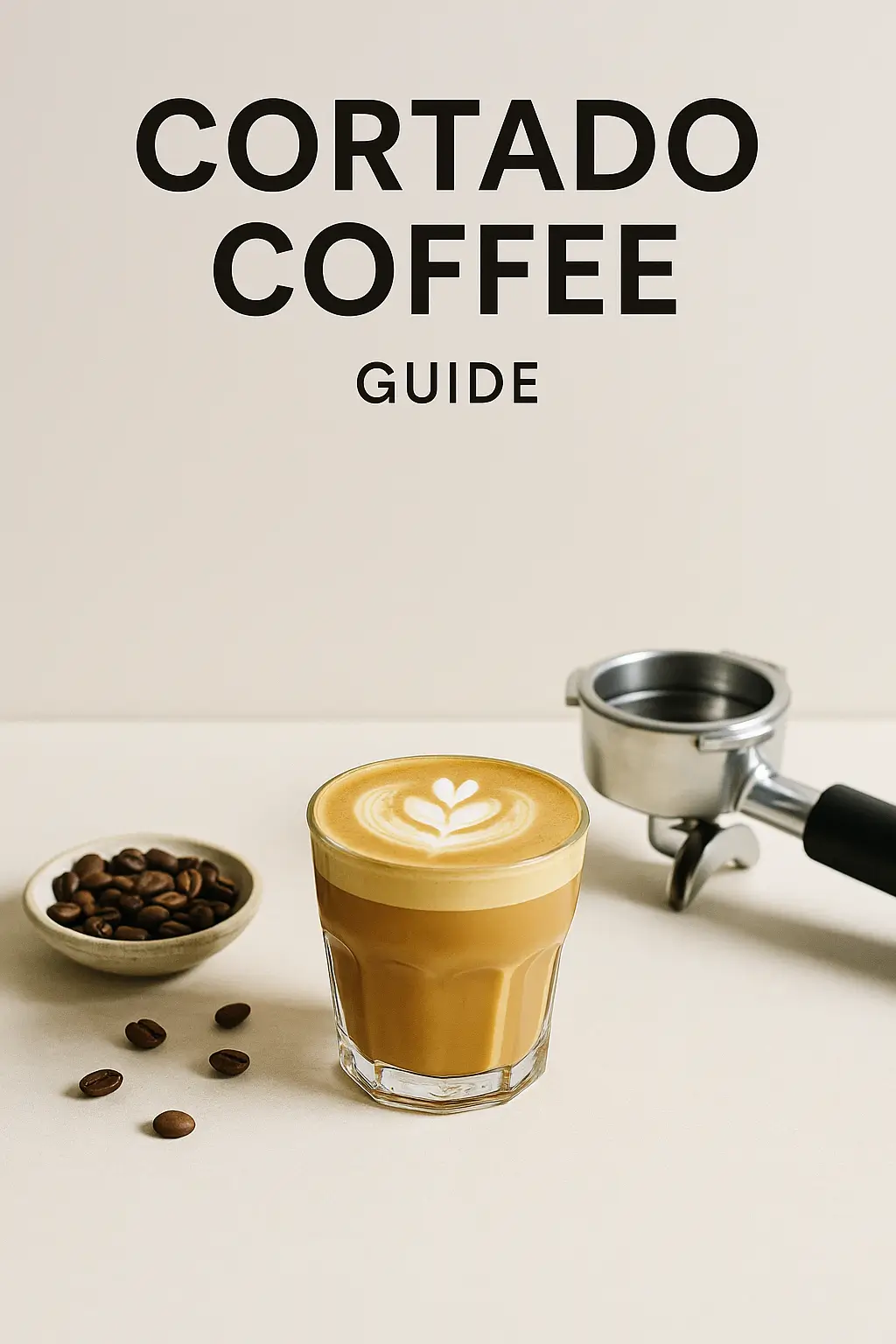You’ve probably heard of lattes or cappuccinos, but have you ever tried a cortado? It’s a bit of a hidden gem in the coffee world, a truly unique and beautifully balanced espresso-based drink. Originally from Spain, its name actually means “to cut,” which perfectly describes how the steamed milk cuts through the espresso’s intensity, creating a smooth, yet robust experience. If you’re someone who loves the rich taste of espresso but finds it a little too bold on its own, a cortado might just become your new favorite.
What is a cortado? Characteristics and essential ingredients
So, what exactly is a cortado? It’s all about balance. At its heart, a cortado is a simple, yet perfectly balanced drink made with equal parts espresso and steamed milk. But it’s not just any steamed milk. The secret? It’s in how the milk is steamed: to a velvety texture with hardly any foam. That’s what really sets it apart from other popular coffee drinks. Think of it as showcasing the espresso without letting the milk overpower it, creating a consistently smooth, rich flavor profile.
Characteristics of a cortado
- 1:1 espresso to milk ratio: This is what defines a cortado. You get an even blend of espresso and milk, so neither flavor overpowers the other—just perfect harmony.
- Steamed, lightly foamed milk (microfoam): The milk is steamed to a fine, velvety texture, with hardly any foam. Unlike frothier drinks, this gives the cortado a super smooth, dense feel in your mouth.
- Small serving size: You’ll usually get a cortado in a compact 4 to 6-ounce glass. This smaller size really highlights its concentrated, rich flavor, making it a quick, intense, and satisfying drink.
- Traditionally unsweetened: You’ll often find cortados served without added sugar. That’s because the steamed milk’s natural sweetness is usually enough to beautifully complement the espresso, creating a subtly sweet, balanced taste on its own.
Essential ingredients for a perfect cortado
Crafting a perfect cortado really comes down to two things:
- Espresso: You’ll need a high-quality single or double shot of espresso. This is the core of the drink, giving it that concentrated coffee flavor.
- Steamed milk: This isn’t just any steamed milk; it needs to be velvety and smooth, not bubbly or overly foamy. Getting this right makes all the difference for the cortado’s signature texture and balanced taste.
The art of making a cortado: preparation method
Making a cortado is an art, really, and it hinges on the specific way you handle the milk. Unlike lattes or cappuccinos, the milk needs to be integrated without creating a fluffy foam. It’s all about getting that smooth, velvety texture and then expertly pouring it to blend it perfectly with the espresso.
Steaming the milk for a cortado
The trick to steaming milk for a cortado is achieving a creamy, velvety texture without introducing much air or creating froth. You want to heat the milk just enough to make it silky and dense. This means stopping before it gets frothy or develops a thick layer of foam. The goal is to produce a smooth, almost liquid milk that blends seamlessly with the espresso, so the coffee’s strong flavor can really shine, while still offering that lovely, balanced taste.
The pouring technique: achieving the perfect balance
Once you’ve got your perfectly steamed milk, the pouring technique really matters. You’ll want to pour the milk slowly and directly into the espresso, aiming for that 1:1 ratio. This careful, steady pour isn’t just for aesthetics; it ensures that the milk truly “cuts” the espresso’s intensity without diluting its rich flavor. It’s how you achieve that signature harmony between the strong coffee and the creamy, dense milk.
Cortado vs. other coffee drinks: key differences
It’s easy to confuse a cortado with other popular espresso-based drinks, but they each have their own distinct personality. The differences often come down to milk volume, texture, and how much the milk mellows or complements the espresso’s flavor. Let’s break down how a cortado stands apart from its closest relatives.
Cortado vs. macchiato
When you compare a cortado to a macchiato, you’ll find a pretty clear distinction. A cortado is made with equal parts espresso and steamed milk, typically in a 4 to 5-ounce serving, giving you a wonderfully balanced flavor. A macchiato, however, is a shot of espresso “marked” with just a tiny dollop of foamed milk. It’s designed to really highlight the espresso flavor, with the milk playing a much smaller, accentuating role.
Cortado vs. flat white
The difference between a cortado and a flat white often comes down to their milk-to-espresso ratio and milk texture. A cortado maintains that 1:1 ratio of espresso to steamed milk, and its milk is specifically steamed without much froth, creating a smooth, dense texture. A flat white, on the other hand, usually has a higher ratio of espresso to milk, often around 1:3, and features a smooth, velvety microfoam that’s perfectly blended, giving it a milder, creamier profile.
Cortado vs. latte
When it comes to a cortado versus a latte, the main difference you’ll notice is the volume of milk. A cortado keeps things concentrated with its equal parts espresso and milk, offering a stronger coffee taste with less milk overall. A latte uses a much higher milk-to-espresso ratio, typically around 1:3, and often comes with a prominent layer of microfoam on top, resulting in a significantly milkier, creamier drink.
| Drink Name | Espresso to Milk Ratio | Milk Texture/Volume | Primary Characteristic |
|---|---|---|---|
| Cortado | 1:1 | Velvety, very little foam (microfoam) | Balanced, espresso-forward, smooth |
| Macchiato | Espresso “marked” with milk | Tiny dollop of foam | Highlights espresso, intense |
| Flat White | 1:3 (higher milk ratio) | Smooth, velvety microfoam, seamlessly integrated | Milder, creamier, espresso still present |
| Latte | 1:3+ (much higher milk ratio) | Prominent layer of microfoam | Milkiest, creamy, less espresso-forward |
The history and cultural significance of the cortado
The cortado isn’t just a coffee drink; it’s a small piece of culinary history with deep roots in Spanish culture. It’s fascinating to see how it originated and then spread from its origin to become a beloved staple in coffee shops worldwide.
Origins in Spain
The cortado first appeared in the Basque region of Spain. Its name, derived from the Spanish verb “cortar,” literally means “to cut.” This refers to how the milk is used to “cut” or mellow the inherent bitterness of espresso. Traditionally, the drink has always been made with equal parts espresso and steamed milk, creating a perfectly balanced flavor that reduces bitterness without losing any of that bold espresso character.
Global popularity and third-wave coffee culture
From its humble beginnings in Spain, the cortado traveled across the Iberian Peninsula, made its way to Latin America, and eventually gained real popularity in the U.S. This surge in popularity in the States coincided with the rise of third-wave coffee culture, where there’s a greater appreciation for high-quality, nuanced coffee experiences. You might even hear it referred to as a “Gibraltar” in some U.S. coffee shops, which can sometimes lead to a bit of confusion, but they’re essentially the same balanced, espresso-forward drink.
Serving the perfect cortado: size and glassware
How a cortado is served is just as important as how it’s made. The typical serving size and the type of glassware used aren’t just arbitrary choices; they’re part of what makes the drinking experience so good—from how it looks to keeping it at the right temperature and flavor.
Typical serving size
A cortado is usually served in a compact size, generally around 4 to 6 ounces (about 120 to 180 ml). Many people, especially in specialty coffee shops, prefer to use a 4-ounce or 4.5-ounce Gibraltar glass. This smaller volume, combined with its classic 1:1 espresso-to-milk ratio, means you get a concentrated yet perfectly balanced flavor in every sip.
Recommended glassware and its impact
- 4 oz Gibraltar glass: This is arguably the most iconic choice for a cortado. Its specific size and shape are ideal for making the drink look its best and keeping it at the perfect temperature.
- Clear glass (often double-walled): Using a clear glass, especially a double-walled one, lets you really appreciate the visual layering of the espresso and milk. It’s not just for show, though; it also helps baristas fine-tune their pouring technique and makes the whole experience even better.
- Ceramic cups: While not as traditional as glass, ceramic cups can also be used. However, many specialty coffee spots just prefer glass for both its look and practical side.
The compact serving size and choice of glassware really work together to highlight what makes the cortado special. It’s meant to be a flavorful, concentrated coffee drink with a silky-smooth feel—never watered down or heavy with too much milk or foam. This whole setup gives you a uniquely elegant and satisfying coffee experience, totally different from bigger, foamier drinks.
Conclusion
A cortado really shines if you’re looking for an espresso-forward drink that’s rich and intense but still wonderfully smooth. Its genius lies in that perfect 1:1 balance of espresso and steamed milk, delivering all the robust flavor you love without any of the bitterness. It’s a nuanced, concentrated, and elegantly simple coffee that consistently hits the spot.









